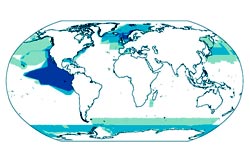Whales Fall through the Research Net

There are enormous gaps on the world map of whale observation, especially in international waters. Only the areas shaded dark blue have been surveyed several times in the past decades.<br>
A world map created by scientists of the universities of Freiburg and St. Andrews, Scotland, reveals that only a fourth of the world ocean surface has been surveyed for whales and dolphins in the past decades.
It is only possible to identify detrimental influences and collect basic information for research and environmental protection if data on marine organisms is collected regularly. First and foremost, it will be necessary to observe international waters more closely and develop new analytical methods, conclude the scientists in their study in the journal PLoS ONE.
The team combed through more than 400 studies on whales conducted between 1975 and 2005 for their study. The scientists digitalized thousands of maps, and in doing so identified alarming gaps. They determined that most of the extensive observations have taken place in the waters of economically strong nations in the northern hemisphere, particularly those of the USA and Europe.
With the exception of the Antarctic waters, where the International Whaling Commission is monitoring the reduction of the Minke Whale population by Japanese whalers, there are enormous areas in the southern hemisphere in which whale populations have not been surveyed at all in the past decades.
The researchers ascertained that the main reason for observing whales is the market for “dolphin-friendly” tuna, whose production requires ensuring that no dolphins are killed by incidental capture. “The eastern tropical Pacific has thus been studied more often than all other marine areas put together,” says the Freiburg marine biologist Dr. Kristin Kaschner. But even these relatively well researched areas lie on the lower end of the scale with regard to the necessary observation frequency. In order to track temporal changes, Kaschner explains, it is important to observe the populations of marine mammals as regularly as possible. “This is currently only the case for six percent of the surface of all oceans,” says Kaschner.
However, a sufficient pool of data on the populations of whales and dolphins is a precondition for successful research and effective protection of marine mammals. They were decimated by whaling in the past and are still threatened today by military sonar systems, bycatch, and water pollution. The scientists argue that international efforts to maintain biodiversity should lead to the development new approaches to data collection. Particularly important is the question as to what effect sound sources like sonar systems or seismic exploration of potential oil or gas reserves have on whales. “Gaps in data have an impact on all aspects of marine biology and planning, from fishery policy to marine protected areas,” says Kaschner. “The data we have on sharks, deep-sea creatures, and marine viruses is even patchier.”
Original Publication:
K Kaschner, N Quick, R Jewell, R Williams, C Harris. Global coverage of cetacean line-transect surveys: status quo, data gaps and future challenges. PLoS ONE, 2012.
http://dx.doi.org/10.1371/journal.pone.0044075
Contact:
Dr. Kristin Kaschner
Institute of Biology I
University of Freiburg
Phone: 0761/203-2566
E-Mail: Kristin.Kaschner@biologie.uni-freiburg.de
Media Contact
All latest news from the category: Ecology, The Environment and Conservation
This complex theme deals primarily with interactions between organisms and the environmental factors that impact them, but to a greater extent between individual inanimate environmental factors.
innovations-report offers informative reports and articles on topics such as climate protection, landscape conservation, ecological systems, wildlife and nature parks and ecosystem efficiency and balance.
Newest articles

Properties of new materials for microchips
… can now be measured well. Reseachers of Delft University of Technology demonstrated measuring performance properties of ultrathin silicon membranes. Making ever smaller and more powerful chips requires new ultrathin…

Floating solar’s potential
… to support sustainable development by addressing climate, water, and energy goals holistically. A new study published this week in Nature Energy raises the potential for floating solar photovoltaics (FPV)…

Skyrmions move at record speeds
… a step towards the computing of the future. An international research team led by scientists from the CNRS1 has discovered that the magnetic nanobubbles2 known as skyrmions can be…





















